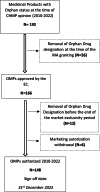Trends in orphan medicinal products approvals in the European Union between 2010-2022
- PMID: 38413985
- PMCID: PMC10900541
- DOI: 10.1186/s13023-024-03095-z
Trends in orphan medicinal products approvals in the European Union between 2010-2022
Abstract
Background: Over the last twenty years of orphan drug regulation in Europe, the regulatory framework has increased its complexity, with different regulatory paths and tools engineered to facilitate the innovation and accelerate approvals. Recently, the proposal of the new Pharmaceutical Legislation for the European Union, which will replace at least three Regulations and one Directive, was released and its new framework is raising many questions. The aim of this study was to present a characterisation of the Orphan Medicinal Products (OMPs) authorised by the European Commission (EC), between 2010 and 2022, looking into eighteen variables, contributing to the ongoing discussion on the proposal and implementation of the new Pharmaceutical Legislation proposed.
Methods: Data of the OMPs identified and approved between 2010 and 2022 were extracted from the European Public Assessment Reports (EPARs) produced by the European Medicines Agency. Information regarding legal basis of the application, applicant, protocol assistance received, type of authorization, registration status, type of molecule, ATC code, therapeutic area, target age, disease prevalence, number of pivotal clinical trials supporting the application, clinical trial designs, respective efficacy endpoints and number of patients enrolled in the pivotal clinical trials were extracted. A descriptive statistical analysis was applied.
Results: We identified 192 OMPs approved in the period between 2010 and 2022. 89% of the OMPs have legal basis of "full application". 86% of the sponsors received protocol assistance whereas 64% of the MAA benefited from the accelerated assessment. 53% of the active substances are small molecules; about 1 in 5 molecules are repurposed. 40% of the OMPs have oncological therapeutic indications and 56% of the OMPs are intended to treat only adults. 71% of the products were approved based on a single pivotal trial.
Conclusions: This analysis of OMPs approved between 2010 and 2022 shows that a shift has occurred in the rare disease medicine development space. Through the period studied we observe an increase of non-small molecules approved, accelerated assessment received and non-standard MA's granted.
Keywords: Accelerated assessment; Incentives; Orphan medicines; Orphan regulation; Rare diseases.
© 2024. The Author(s).
Conflict of interest statement
The authors declare that they have no competing interests.
Figures




Similar articles
-
Orphan drugs, orphan diseases. The first decade of orphan drug legislation in the EU.Eur J Clin Pharmacol. 2013 Apr;69(4):1009-24. doi: 10.1007/s00228-012-1423-2. Epub 2012 Oct 23. Eur J Clin Pharmacol. 2013. PMID: 23090701
-
Orphan medicinal products in Europe and United States to cover needs of patients with rare diseases: an increased common effort is to be foreseen.Orphanet J Rare Dis. 2017 Apr 3;12(1):64. doi: 10.1186/s13023-017-0617-1. Orphanet J Rare Dis. 2017. PMID: 28372595 Free PMC article.
-
Feasibility of disease terminology systems for mapping orphan conditions and therapeutic indications of designated orphan medicines in the European Union.Eur J Pharm Sci. 2024 Nov 1;202:106871. doi: 10.1016/j.ejps.2024.106871. Epub 2024 Aug 5. Eur J Pharm Sci. 2024. PMID: 39111579
-
Review and comparison of clinical evidence submitted to support European Medicines Agency market authorization of orphan-designated oncological treatments.Orphanet J Rare Dis. 2015 Oct 28;10:139. doi: 10.1186/s13023-015-0349-z. Orphanet J Rare Dis. 2015. PMID: 26511061 Free PMC article. Review.
-
European regulation on orphan medicinal products: 10 years of experience and future perspectives.Nat Rev Drug Discov. 2011 May;10(5):341-9. doi: 10.1038/nrd3445. Nat Rev Drug Discov. 2011. PMID: 21532564 Review.
Cited by
-
The clinical assessment of studies on orphan drugs in relation to the EMA's authorization marketing decisions in Europe.Front Pharmacol. 2025 Mar 31;16:1558987. doi: 10.3389/fphar.2025.1558987. eCollection 2025. Front Pharmacol. 2025. PMID: 40230693 Free PMC article.
-
Advancing Regulatory Oversight of Medical Device Trials to Align with Clinical Drug Standards in the European Union.Pharmaceuticals (Basel). 2025 Jun 12;18(6):876. doi: 10.3390/ph18060876. Pharmaceuticals (Basel). 2025. PMID: 40573269 Free PMC article. Review.
References
-
- Regulation (EC) No 141/2000 of the European Parliament and of the Council of 16 December 1999 on orphan medicinal products. Official Journal of the European Union. 2000;L 18:1–5.
MeSH terms
Substances
LinkOut - more resources
Full Text Sources
Medical
Research Materials

